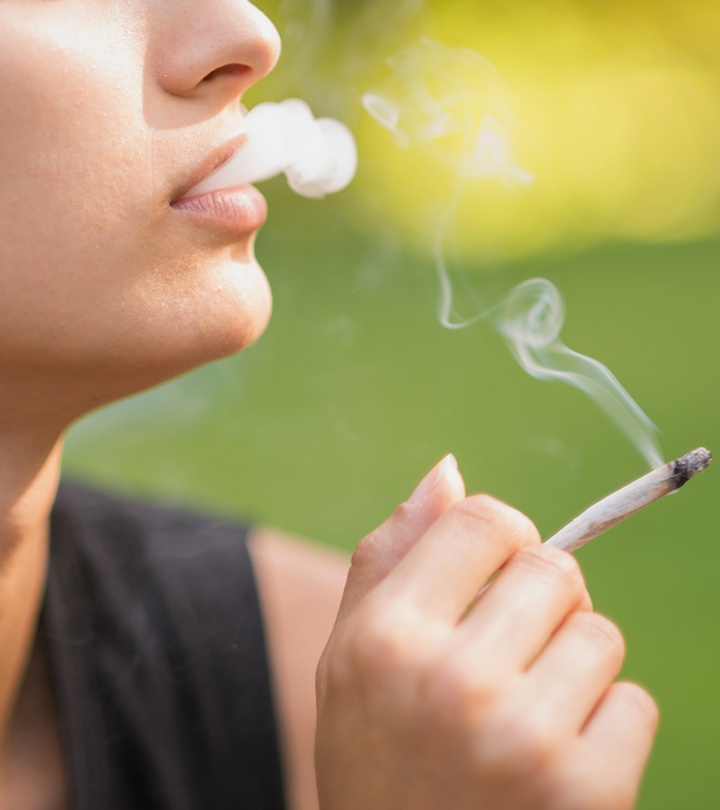Cigarette smoking, which is the most common form of tobacco use, is estimated to kill more than 8 million people worldwide (1). But, are you aware of the lesser-known consequences of smoking? The external effects of smoking, while not deadly, can still be extremely demoralizing.
Smoker’s lips are one such consequence of long-term smoking. In this condition, the skin around the mouth develops vertical wrinkles. Also, your lips and gums become significantly darker on account of hyperpigmentation.
Keep reading to find out why your lips turn black when you smoke and how to counter this effect of cigarettes.
In This Article
Does Smoking Make Your Lips Black?
Yes. Studies show a striking connection between smoking and pigmentation in the lips (2). Additionally, tobacco smoking can affect your overall skin, with one study noting the impact on thickness and density of dermis, epidermis, and nasolabial folds (3).
Another study found the scores of lip and gum pigmentation in smokers to be 7 and 4 times higher than those of non-smokers (4).
Why Is Smoking So Bad For Your Lips?
Shutterstock
The main culprit of the effects of aging on the skin is nicotine and other cancerous chemicals in cigarettes.
Nicotine and benzopyrenes are some chemicals present in tobacco that can boost melanin production in your skin, leading to hyperpigmentation and smoker’s lips (5). Nicotine causes blood vessels to become narrow, thereby reducing oxygen flow and nutrients to the skin cells. The chemicals present in cigarettes further trigger molecular events that damage skin elasticity and collagen production.
The particular motion of pursing your lips to hold and smoke a cigarette also contributes to lines around the mouth. With time, the heat and uninhaled smoke dry out and damage the surface of the skin.
The extent of exposure to smoke and the number of cigarettes smoked affect the chances of wrinkles and other age-associated changes to the face. And, the combination of unprotected sun exposure and smoking can make things worse.
Find out the signs of smoker’s lips in the next section.
What Are The Signs Of Smoker’s Lips?
The lips of heavy smokers have a bluish-black discoloration. The toxins from smoke cause constriction of blood vessels, causing dryness and irritation. Smoking may cause your skin to lose elasticity, thereby producing wrinkles (6).
If you have black lips from smoking and want to treat them, continue reading the next section.
How To Fix Smoker’s Lips
Many natural and medical treatments can help fix smoker’s lips. Read on for specific treatment options for hyperpigmentation and wrinkles.
Treatment For Hyperpigmentation Of Lips
Shutterstock
- Exfoliation: A DIY exfoliating treatment made from a combination of coarse salt or sugar followed up by moisturizer can help lighten lips. Studies suggest that exfoliating products containing glycolic acid can combat hyperpigmentation (7).
- Lip Masks: There is some anecdotal evidence to suggest that lip masks containing a combination of turmeric and lemon juice can help lighten lips. Add vitamin A or E oil for added benefit.
- Laser Treatment: Lip laser treatment uses concentrated pulses of light that penetrate deep into the skin’s layers to restore your lips’ natural color. In addition, laser treatments can help with stimulating collagen production and erasing vertical wrinkles around the mouth. One study found that a single session of 1064 nm Q-switched neodymium-doped yttrium aluminum garnet (NdYAG) laser treatment can be quite effective (5).
Treatment For Lip Wrinkles
Shutterstock
- Moisturizing: A rich moisturizer containing tretinoin helps build collagen and reduce the appearance of wrinkles and fine lines (8).
- Injections: Injected medication such as Botox is a more long-term solution. It is super efficient for smoothening out wrinkles around the lips.
- Laser Resurfacing: Laser peeling is a treatment that removes the uppermost damaged layer of skin. Ablative lasers penetrate the skin to smoothen out wrinkles (9).
- Fruit Acid Peels: Natural peels Acid peels can be used on and around the lip area to reduce wrinkles and lighten dark patches. Deep peels can fight wrinkles if used the right way (10).
- Dermal Fillers: Fillers that contain hyaluronic acid plump up the skin around the mouth, thereby reducing the appearance of wrinkles (11).
StyleCraze Says The results of laser therapy may last for 3 to 5 years. You can also extend the results beyond 5 years if you take proper care of your lips and quit smoking.
The best way to reduce smoking-related consequences like pigmented lips and wrinkles around the mouth is to stop smoking altogether. Find out how to quit smoking and prevent smoker’s lips below.
Prevention Tips For Smoker’s Lips
Shutterstock
Some tips you can use to quit smoking are listed below:
1. Set A Quit Date
Long-term smokers need to be organized and determined about quitting. It helps to pick a date and share it with friends and family to make you accountable to them. Plan out the possible challenges and prepare possible solutions for them.
Setting an action plan around handling withdrawal symptoms and cravings can reduce anxiety on the D-date. Healthy distractions for the hand or mouth, like nicotine gum and patches, might help.
2. Quitting Cold Turkey
While it may seem monumental, quitting cold turkey has been found to be more effective than a gradual cut down in the number of cigarettes you smoke. Counseling support and nicotine patches can make the process easier.
3. Support
It is important for people who decide to quit smoking to consider it as a long-term endeavor. Know that it may take multiple tries to quit for good. As such, you may need additional support from counselors or mobile apps to succeed in the long run.
Wondering how to get rid of black lips from smoking? Read on for a list of solutions.
Treatments For Smoking
Various medications for smoker’s lips can help increase quit rates. When combined with counseling, these medications can be effective in managing cravings, withdrawal symptoms, and even side effects of quitting smoking.
As Varenicline and Bupropion require time to show effects, they should ideally be started a week to several weeks before the official quit date. Make sure to consult a medical professional to ensure the medications do not interact with any other medications you are on.
1. Nicotine Replacement
Shutterstock
Nicotine replacement helps with smoking addiction, withdrawal symptoms, and cravings. There are many options for nicotine replacement, ranging from over-the-counter to prescription solutions. These include patches, gum, lozenges, nasal spray, and inhaler.
Keep in mind that the highest dose patch must be used when the tobacco consumption is more than 10 cigarettes a day.
StyleCraze Says You should wear the patch for 24 hours, even when sleeping or bathing. However, if you find your sleep disturbed, you may remove the patch before going to bed and put a new one on the following day.
2. Varenicline (Chantix)
Varenicline reduces withdrawal symptoms by binding to nicotine receptors in the body. At the same time, it blocks them from the nicotine in cigarettes, making smoking less pleasurable. This medication works best in combination with other treatments. However, more studies are needed to confirm the benefits of Varenicline (12).
3. Bupropion (Zyban, Wellbutrin SR)
Bupropion can help you quit smoking by working on the brain’s hormones. It also prevents weight gain, a common initial symptom when you stop smoking. Treatment for a longer duration may help prevent relapse in those who have quit. However, note that it cannot be used for those who have a history of seizure disorders (13).
If these treatments for smoking don’t work individually, they can be tried in combination and even coupled with alternative solutions like acupuncture and hypnosis. The prognosis for success for alternative treatments is not certain. However, when used with more effective treatment options, they can help.
If you want to stop smoking, talk to your doctor about the best options for you to help you succeed.
Does Quitting Smoking Improve Your Skin?
Unfortunately, quitting smoking cannot reverse the damage to your skin. But by quitting, you can prevent the damage from worsening. One study noted that melanin was significantly reduced in just 4 weeks after quitting smoking (14). So, it can safely be said that quitting smoking can improve the health and appearance of your skin.
Key Takeaways
- Excessive smoking causes smokers’ lips, a condition characterized by vertical wrinkles around the mouth and darkening of the lips.
- Exfoliation, lip masks, laser treatment, moisturizing, injections, laser resurfacing, acid peels, and derma fillers are just a few of the natural and medicinal therapies that can help improve a smoker’s lips.
- Quitting smoking is the most effective approach to prevent smoking-related effects such as pigmented lips and creases around the mouth.
People who smoke develop a bluish-black discoloration of lips known as smoker’s lips. The toxins from tobacco smoke affect your blood vessels, resulting in dryness and irritation. This may also lead to loss of skin elasticity, hyperpigmentation, and wrinkles. You can get rid of smoker’s lips with methods like exfoliation, wearing lip masks, moisturizing, laser treatments, injections, acid peels, and dermal fillers. You can quit smoking and follow the preventive methods mentioned in the article to avoid recurrence and worsening of smoker’s lips.




